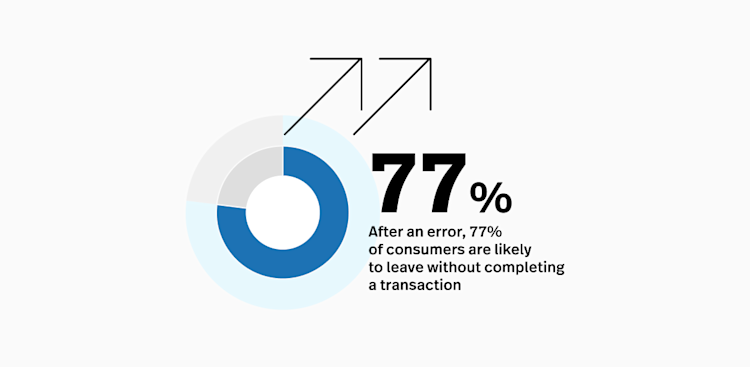Article summary: We surveyed 1,500 consumers in North America to find out what digital issues they find most frustrating when transacting online and what they do when they encounter issues. The key takeaway from their responses is clear: digital is here to stay, and it’s time to double down on understanding and improving your digital experience.
Online transactions have hit record highs throughout the COVID-19 pandemic, and companies across industries–from retail and dining to banking and healthcare–have seen their digital channels become their chief means of reaching and engaging customers.
While this spike in online transactions may have seemed temporary at first, it’s become clear that the digital-first mindset is here to stay.
Data backs this up. We recently surveyed 1,500 North American shoppers, and found that 8 in 10 (81%) plan to increase or maintain their online usage, even when in-person activities resume.
This means that organizations that have focused on their digital experiences thus far should continue to prioritize them. And for organizations that have been holding out for in-person transactions to return: now is the time to invest in your digital strategy.
So, what did the survey tell us about consumers’ perceptions and expectations for digital shopping experiences? Here are a few key takeaways.
Takeaway #1: Not all digital experiences are created equal
A seamless digital experience is a beautiful thing: a shopper locates the product they want, adds it to their cart, pays for it, and ultimately receives it at their door.
What makes a “good” digital experience in the eyes of consumers? According to the survey, 83% of respondents say that the most important factor is simply being able to “quickly accomplish what I came to do.”
Unfortunately, things don’t always go this well. Digital issues and frustrations–like a product selection that’s difficult to navigate, a “view cart” button that doesn’t work, or a page that won’t load–are shockingly common.
The survey found that 64% of respondents have been frustrated or struggled with an online transaction in the last six months.
Additionally, consumers reported that some industries are already excelling at digital experience, while others have some catching up to do:
Retailers were ranked the highest by survey respondents, rated 34% excellent and 7% poor.
Banks followed closely, with 26% excellent and 7% poor.
Airlines have the worst digital experiences, rated 27% poor and 10% excellent.
Hotels and quick service restaurants also ranked low, with 13% poor and 7% excellent.
Takeaway #2: Digital errors are costly for businesses
Friction in your digital experience can hamper retention rates, erode customer trust, and ultimately have a direct impact on your bottom line. Data from the the survey showed:
Seventy-seven percent of consumers (3 out of 4) reported that they will leave without completing a transaction if they encounter an error–which means that minor issues on your site can result in enormous losses in revenue.
After encountering just one such error on a site, 60% of respondents say they are unlikely to return to that site in the future, shrinking your pool of potential customers.
Of survey respondents, 65% say they trust a business less when they experience a problem using a website or mobile app, ultimately splintering customer relationships and loyalty.
As evidenced by the survey, it’s critical that you clear the path for customers to make transactions through your digital channels.
Takeaway #3: Even when people report problems, it's most likely through manual and time-consuming methods
Unfortunately, most customers who experience digital issues don’t take the time to report them–they simply leave to find a site with a more seamless experience. Of the survey respondents, only 12% say they are very likely to provide feedback to the business when they have a problem.
The act of leaving feedback is often itself a frustrating, time-consuming experience. Forty-nine percent of survey respondents said they report issues through surveys, while 41% and 40% do so by chatting or emailing the company, respectively. The catch? Most of these reports don’t go directly to the team that can actually fix the issue, leading to long ticket resolution times and other snags. Plus, it costs organizations thousands to employ teams to monitor and address the feedback.
What kinds of common issues might these users be trying to report? According to the survey, the most frustrating issues for consumers are:
Page glitches (55%)
Forms that don’t accept inputs correctly (45%)
Page load errors (42%)
Reveal the flaws in your digital experience–and figure out how to fix them–with Fullstory
Now, more than ever, you need to understand what your customers are doing (or are unable to do) on your website. Digital transactions will continue to rise, and investing in scalable digital experience intelligence now is critical for your business’s long-term growth.
“The rise of digital-first business brings great opportunity but also risk, as this survey correlates a poor digital experience with customer and revenue loss. To be successful, businesses must understand not only what is happening in their customers’ experiences, but most importantly why, in order to stay one step ahead of digital users.” - Kirsten Newbold-Knipp, CMO at Fullstory
With Fullstory, you can see exactly when, where, and why customers are leaving your website, and identify and prioritize the changes you need to make in order to keep them. (It’s like having a pair of magic goggles for your website 😎.)
Whether you’re just beginning to think about your digital experience strategy, or you’re ready for a more robust digital experience intelligence solution, Fullstory’s data and analytics have the answers you need. Get a demo today.








